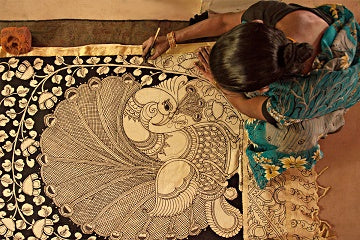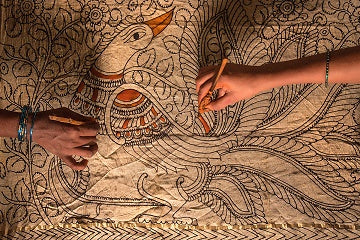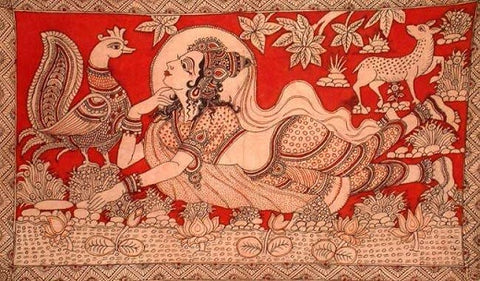Tales of Forlorn Art: Kalamkari
Nov 26, 2017
The extraordinary beauty of Kalamkari art reflected through sheer historical tradition depicted in paintings, murals, handcrafted textiles resonates the deep cultural-connect permeating the very essence of social values, morals and societal status. The word Kalamkari century.
Chitrakattas And Their Relevance

century in Andhra Pradesh when the chiktrakattas spread enlightenment about its historic relevance and lured in communities to embrace the handcrafted glory. These chirtrakattas were mainly the vagabonds who traveled to far-away places to showcase their art and were mainly musicians, painters, and artists. Therefore, the painting and art showcased in Kalamkari work are known as Chitrakattas.
History And Development
During the reigns of Golconda Sultanate of Hyderabad, this traditional Indian art form rose to prominence and the Chitrakattas were praised and acknowledged for their immense knowledge as they exhibited Kalamkari to the then rulers. Furthermore, the Mughal rulers in the Coromandel province and Golconda State patronized the skill of craftsmen producing this vibrant art depicting the Indian cultures. And they called them “Qualamkars”, that’s how Kalamkari came into vogue.

The artists always used the natural vegetable dyes for the textiles and ditched the synthetic dyes. As the British also grew their interest towards this art form, the artists were deeply renowned for their textiles and handcrafted pieces were now being exported to other parts of the world. Therefore, the craftsmen began to experiment with their designs and took inspiration from the Persian motifs to adorn the sartorial blocks of beauty. Kalamkari trading was generally done in Barter Deals just like the spice trade in ancient times. Since Andhra Pradesh had the skilled artisans for this job, Sri Kalahasti and Machilipatnam became the focal centers for Kalamkari production as water supply which is one of the most important pre-requisite for Kalamkari was available in these places.
Sri Kalahasti was the most important Hindi pilgrimage site because of the Sri Kalahastisvara temple which is widely known for its architecture and deep sect belongingness towards Lord Shiva. The Kalamkari textiles Century AD).

century and that’s when the trading of Kalamkari experienced a high. The designs reflected the social scenario of the contemporary word including the geometric figures, animals, stylised plants, creepers, women etc.
Process Of Making Kalamkari Art
As we have already learnt that Kalamkari artwork is mainly divided into two different specializations: Sri Kalahasti and Machilipatnam. In both the artforms, the cloth is first washed with water thoroughly to remove the excess starch and other oily substances. After drying, the cloth is then dipped into buffalo milk and myrobalan fruit dust (traditional homegrown fruit) and then the excess solution is squeezed out.
Let’s first understand how the former is curated.
In Sri Kalahasti artwork, the initial sketch is made by using the charcoal pencil which is made by the burnt twigs of the tamarind tree. Bamboo pens are used for coloring the kalamkari cloth and while one tip is carved for etching the intricate details on the cloth, the other needle hooks up the cotton cloth with thread to further the signature design. This process is called as “kasim” where about 500 grams of sugar jaggery, 100 grams of palm jaggery and one kg of rusted iron is used in 10 liters of water. Once the bamboo pen dips into kasim for drawing, gently squeeze the excess liquid and resume with the designing. To remove the ink, one blot of cotton is kept beside the craftsmen. Since only natural and vegetable dyes are used as inks instead of synthetic colors, the artisans make use of alum water to paint red. Generally, with such solid colors, the background is kept red itself to avoid spill of ink. Also, their authentic colors might be different as the original red color shall be too dark as compared to natural red which will appear to be pale red.
In Machilipatnam, the textiles are washed at the Kalai Canal as the ritual holds it. Later, once the cloth is dried completely, the units of workers are divided into several sub-units and it involves a much more collaborative production. There are no drawings and sketches involved rather the workers use wooden blocks for printing. For both the textile; monochromatic and polychromatic, the wooden blocks shall be different. The first sub-unit comprises of the skilled carpenters who are involved in the making of wooden blocks. They use the cross section of teakwood. The positive area of the wooden block is the one that features the design and has color to it and is outwardly situated as compared to the sunken negative area. This process is called as the relief process and for coloring process, it usually begins with the coloring and filling-in of inner portions the design. For polychromatic design, red and black outlining are done first and then the cloth is boiled and dried out. All the colors are stored in the large wooden blocks which are layered with cotton and jute fabrics. After printing, these textiles are then taken to washing sub-units which are open from all the four sides. There are big vessels made of iron placed over the ovens where these fabrics will be boiled. These ovens till today run on wood powder and rice husks. While boiling, the local leaves gaja are added to the textiles so as to fix the color. Post this process, fabrics are washed again and later, they are embellished by hand and finished with an impeccable weave.
Artisans Aesthetics
The geographic location of Andhra Pradesh works in favor of the artisans and craftsmen producing Kalamkari textiles for Andhra Pradesh and the neighboring Kerala and Tamil Nadu are the hubs of producing cotton which is the primary raw material used in kalamkari artform. The natural dyes are skilfully prepared by the artists using vegetables like tomato, eggplant, ladyfinger, potatoes etc. to add the mild flavor of color in their handcrafted produce. Another favorable aspect is the proximity to water sources which is extremely important for manufacturing kalamkari. River Swarnmukhi flowing through Sri Kalahsti greatly helps the artisans while the canal in Machilipatnam is a great sub-unit for artisans to procure and finish their product with a finesse.
The source of inspiration for the design comes from surroundings and therefore, it often reflects the social scenario and the state of the society in realistic terms. While Sri Kalahasti produces fabrics which are detailed and intricate in terms of designing and involves black bold lines as the part of outlining, Machilipatnam involves free-flowing rhythmic patterns of designing. For the first base of painting or coloring, lime is used and then red, ochre and black patterns are involved in the line drawing. The Kalamkari Printers Welfare Association of Machilipatnam works under the registration of GIR Chennai which allows the weavers and artists to claim their trademark rights in case they find someone copying their signature design.
So, here we come to an end with the vibrant and elegant crafts of the South. Kalamkari block printing art is indeed one of the most revered handcrafts and we at Pure Elegance support, enlighten, and empower the artisans by restoring the precious traditional Indian artforms and keeping our culture alive by promoting Kalamkari sarees.